Paperback Travel
 In preparation for this upcoming trip to Burma, my teacher Lila Wheeler (herself a writer, who spent time as a nun in Burma) gave me a reading list of some of her favorite “reference” books. I won’t have time to read them all before I go, but I’m already deeply engrossed in one of them: The Glass Palace, by Amitav Ghosh, which has been hailed as “Doctor Zhivago for the Far East.” If the others are as good as this one, I’ll definitely read them all!
In preparation for this upcoming trip to Burma, my teacher Lila Wheeler (herself a writer, who spent time as a nun in Burma) gave me a reading list of some of her favorite “reference” books. I won’t have time to read them all before I go, but I’m already deeply engrossed in one of them: The Glass Palace, by Amitav Ghosh, which has been hailed as “Doctor Zhivago for the Far East.” If the others are as good as this one, I’ll definitely read them all!
Here’s her list:
Non-fiction
Buddhism and Society: A Great Tradition and its Burmese Vicissitudes, by Melford Spiro
From the Land of Green Ghosts, by Pascal Khoo Thew
Finding George Orwell, by Emma Larkin
The Trouser People, by Andrew Marshall
Letters from Burma, by Aung San Suu Kyi
Burmese Family, by Mi Mi Khaing
Native Tourist, by Ma Thanegi
Novels
The Glass Palace, by Amitav Ghosh
Burmese Days, by George Orwell
The Jewel Trader of Pegu, by Jeffrey Hantover
Graphic Novel
Burma Chronicle, by Guy Delisle
What I’m Reading Now
 I decided to take my name off the wait list for the retreat for experienced students coming up at IMS next March/April, in which both Joseph Goldstein and Bhikkhu Analyao will be teaching on the Satipatthana Sutta. (I was number 169 and a full house is less than 100 yogis.)
I decided to take my name off the wait list for the retreat for experienced students coming up at IMS next March/April, in which both Joseph Goldstein and Bhikkhu Analyao will be teaching on the Satipatthana Sutta. (I was number 169 and a full house is less than 100 yogis.)
But I am consoling myself with Joseph’s new book: Mindfulness, A Practical Guide to Awakening, which is based on a series of 47 talks he gave on this same, key teaching.
For an overview of the book, here’s the intro on the jacket cover:
“The mind contains the seeds of its own awakening–seeds that we can cultivate to bring forth the fruits of a life lived consciously. With Mindfulness, Joseph Goldstein shares the wisdom of his four decades of teaching and practice in a book that will serve as a lifelong companion for anyone committed to mindful living and the realization of inner freedom.”
For an idea of how clear and comprehensive it is, here’s the table of contents:
The Four Qualities of Mind
Ardency: The Long-Enduring Mind
Clearly Knowing: Cultivating Clear Comprehension
Mindfulness: The Gateway to Wisdom
Concentration: The Collected Nature of Mind
The Satipatthana Refrain
Contemplating the Four Foundations
Bare Knowing and Continuity of Mindfulness
Mindfulness of the Body
Mindfulness of Breathing
Mindfulness of Postures
Mindfulness of Activities
Mindfulness of Physical Characteristics
Mindfulness of Feelings
Liberation through Feelings
Worldly and Unworldly Feelings
The Wholesome and Unwholesome Roots of Mind
The Refrain: On Feelings and the Mind
Mindfulness of Dhammas–The Five Hindrances
Desire
Aversion
Sloth and Torpor
Restlessness and Worry
Doubt
Mindfulness of Dhammas–The Five Aggregates of Clinging
Material Elements, Feelings, and Perceptions
Formations and Consciousness
Contemplating the Five Aggregates
Mindfulness of Dhammas–The Six Sense Spheres
How We Experience the World
The Wheel of Samsara
Mindfulness of Dhammas–The Seven Factors of Awakening
Mindfulness
Investigation of Dhammas
Energy
Rapture
Calm
Concentration
Equanimity
Mindfulness of Dhammas–The Four Noble Truths
The First Noble Truth: Dukkha
The Second Noble Truth: The Cause of Dukkha
The Third Noble Truth: The Cessation of Dukkha
The Fourth Noble Truth: The Way Leading to the Cessation of Dukkha
Mindfulness of Dhammas–The Noble Eightfold Path: Wisdom Factors
Right View: Worldly Ease
Right View: Liberation
Right Thought: Renunciation
Right Thought: Lovingkindness
Right Thought: Compassion
Mindfulness of Dhammas–The Noble Eightfold Path: Morality Factors
Right Speech
Right Action and Right Livelihood
Mindfulness of Dhammas–The Noble Eightfold Path: Concentration Factors
Right Effort, Right Mindfulness, Right Concentration
The Realization of Nibbana
***
That ought to keep me busy!
How We Make the World
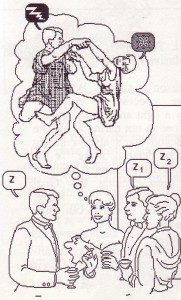 We are what we think.
We are what we think.
All that we are arises with our thoughts.
With our thoughts we make the world.
Speak or act with an impure mind
And trouble will follow you
As the wheel follows the ox that draws the cart.
We are what we think.
All that we are arises with our thoughts.
With our thoughts we make the world.
Speak or act with a pure mind
And happiness will follow you
As your shadow, unshakable.
How can a troubled mind
Understand the way?
Your worst enemy cannot harm you
As much as your own thoughts, unguarded.
But once mastered,
No one can help you as much,
Not even your father or your mother.
***
— text from the Dhammapada, translated by Thomas Byron
— image from Zen & the Art of the Macintosh: Discoveries on the Path to Computer Enlightenment, by Michael Green….another of the treasures I discovered while cleaning out my bookcase!
More Treasure
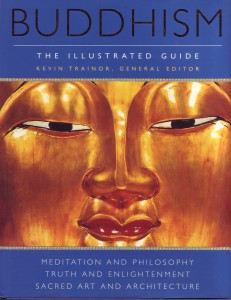 While cleaning out one of my bookcases (see yesterday’s post) I also found — somewhere among the German and Italian dictionaries, catalogues of exhibits at the Tate Modern, guidebooks to hawker food in Singapore, and a 1981 Rand McNally Road Atlas of the US — this gorgeous book on Buddhist art!
While cleaning out one of my bookcases (see yesterday’s post) I also found — somewhere among the German and Italian dictionaries, catalogues of exhibits at the Tate Modern, guidebooks to hawker food in Singapore, and a 1981 Rand McNally Road Atlas of the US — this gorgeous book on Buddhist art!
 And it includes this image of a golden Buddha statue from the Shwedagon pagoda in Yangon, which I hope to be able to see in person…if the latest glitches in getting a VISA finally ever do get worked out.
And it includes this image of a golden Buddha statue from the Shwedagon pagoda in Yangon, which I hope to be able to see in person…if the latest glitches in getting a VISA finally ever do get worked out.
(Oh the joys of exotic travel.)
Let go.
Let go.
Let go.
Buried Treasure
 Now that I’m retired….I mean, now that I’m working full time on my self-directed, self-funded, multi-media, inner research project….I’ve been cleaning out my upstairs study to make room for the art books, post cards, tarot decks, maps, binders, notebooks, and all the other indispensable stuff I used to keep at my office, but now have to find a place for here.
Now that I’m retired….I mean, now that I’m working full time on my self-directed, self-funded, multi-media, inner research project….I’ve been cleaning out my upstairs study to make room for the art books, post cards, tarot decks, maps, binders, notebooks, and all the other indispensable stuff I used to keep at my office, but now have to find a place for here.
And I came across a sweet little book I didn’t know I had, called Teachings of the Buddha, edited by Jack Kornfield. Since I had nothing better to do (remember, I’m a full-time Inner Researcher now), I opened the book at random and read:
Just as water flowing in the streams and rivers fills the ocean, thus may all your moments of goodness touch and benefit all beings, those here and now and those gone before.
May all your wishes be soon fulfilled as completely as the moon on a full-moon night, as successfully as from the Wish-Fulfilling Gem. May all dangers be averted; may all disease leave you.
May no obstacles come across your way and may you enjoy happiness and long life.
May those who are always respectful, honoring the way of the elders, prosper in the four blessings of old age, beauty, happiness, and strength.
(adapted from the Pattanumodana blessings chant)
***
And now I offer this blessing to you.
May it be so.
To Arrive at What You Are Not
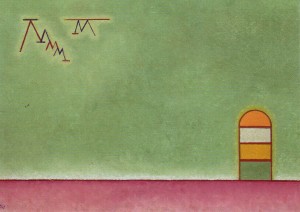 After sitting the weekend retreat with Phillip Moffitt, I came back home and picked up his book, Dancing with Life, which the KM group has been discussing for almost 2 years. The next-to-last chapter is titled: “Now That You Know, What Is It That You Know?”
After sitting the weekend retreat with Phillip Moffitt, I came back home and picked up his book, Dancing with Life, which the KM group has been discussing for almost 2 years. The next-to-last chapter is titled: “Now That You Know, What Is It That You Know?”
Here’s the part that really stood out for me:
Based on my years of experience of working with students, you most likely have some psychological/emotional issues that create an inner sense of scarcity or need in your ego identity that must be worked with before you can finish walking the Eightfold Path…..[This] is what must be released so that something new beyond your ego’s imagination and capacity can enter and flourish.
…It is difficult and confusing to work with your ego’s limitation, no matter what it is. This is because you need the ego’s cooperation in order to act in a manner that at times seems contrary to its own interest. As T.S. Eliot says in “Four Quartets”:
In order to arrive at what you are not
You must go through the way in which you are not.
The journey feels as strange as Eliot’s words because by definition you are “not being yourself,” yet you are being very genuine in not being yourself!
This is the paradox of the inner journey….You aren’t supposed to build your practice around “destroying your ego limitation,” rather you consciously go through your ego limitation in order to be freed from it.
***
(image: Green Vacancy by Wassily Kandinsky)
Invisible Journeys
 One of my all-time favorite books is Invisible Cities, by Italo Calvino. I can’t say that I entirely understand it, but I do love it. I notice that I am often drawn to it when I’m about to start something big–like now, for example–so I thought I’d share a bit of it with you, my Dear Fellow Sojourners.
One of my all-time favorite books is Invisible Cities, by Italo Calvino. I can’t say that I entirely understand it, but I do love it. I notice that I am often drawn to it when I’m about to start something big–like now, for example–so I thought I’d share a bit of it with you, my Dear Fellow Sojourners.
Cities & Desire. 3.
Despina can be reached in two ways: by ship or by camel. The city displays one face to the traveler arriving overland and a different one to him who arrives by sea.
When the camel driver sees, at the horizon of the tableland, the pinnacles of the skyscrapers come into view, the radar antennae, the white and red windsocks flapping, the chimneys belching smoke, he thinks of a ship; he knows it is a city, but he thinks of it as a vessel that will take him away from the desert, a windjammer about to cast off, with the breeze already swelling the sails, not yet unfurled, or a steamboat with its boiler vibrating in the iron keel; and he thinks of all the ports, the foreign merchandise the cranes unload on the docks, the taverns where crews of different flags break bottles over one another’s heads, the lighted, ground-floor windows, each with a woman combing her hair.
In the coastline’s haze, the sailor discerns the form of a camel’s withers, an embroidered saddle with glittering fringe between two spotted humps, advancing and swaying; he knows it is a city, but he thinks of it as a camel from whose pack hang wineskins and bags of candied fruit, date wine, tobacco leaves, and already he sees himself at the head of a long caravan taking him away from the desert of the sea, toward oases of fresh water in the palm trees’ jagged shade, toward palaces of thick, whitewashed walls, tiled courts where girls are dancing barefoot, moving their arms, half-hidden by their veils, and half-revealed.
Each city receives its form from the desert it opposes; and so the camel driver and the sailor see Despina, a border city between two deserts.
Wise Concentration
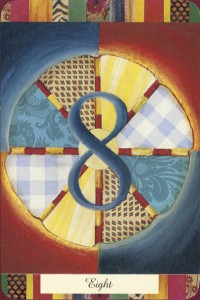 The eighth fold of the Noble Eightfold Path is samma samadhi, usually translated as Wise (or Right) Concentration.
The eighth fold of the Noble Eightfold Path is samma samadhi, usually translated as Wise (or Right) Concentration.
In Dancing with Life, Phillip Moffitt writes:
“Right concentration…empowers your sense of presence in every other aspect of the path. Right concentration is the ability to collect and unify the mind. It enables you to direct your attention to an object of your experience and stay focused on it….
“There are two general types of meditation for establishing the steadiness of concentration that allows you to practice mindfulness: open field attention and deep absorption.
“The first of these, open field, is what the great Burmese meditation teacher Mahasi Sayadaw referred to as momentary concentration, in which your mind is briefly concentrated on a single object. He taught that such short-term concentration is sufficient for gaining insight from mindfulness practice…
“The second approach to practicing formal mindfulness meditation is to start by attaining absorption concentration, with in the Theravada tradition is called jhana. In jhana practice your mind becomes fully concentrated on a meditation object for an indefinite period of time, then moves to ever more subtle levels of awareness. After achieving an intensive state of stillness and one-pointedness, you begin to practice mindfulness…
“The importance of being able to achieve fully absorbed meditation states to attain deepening insight is debated among meditation teachers. There are also differing views as to what level of one-pointedness characterizes such states. But there is no debate about the importance of being able to collect and unify your mind in meditation in order to practice mindfulness. Unfortunately, in my years of experience conducting interviews, I’ve seen that only a modest percentage of students ever develop the concentration potential they naturally have.”
**
I have to admit that sounds fairly daunting.
Ah, but then Phillip goes on to say:
“If you want to develop more concentration capacity, I recommend attending a concentration-oriented meditation retreat, and leave all your ideas about why you can’t concentrate at home.”
Wise Mindfulness
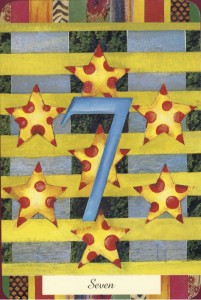 The seventh factor of the Noble Eightfold Path is samma sati, translated as Wise (or Right) Mindfulness.
The seventh factor of the Noble Eightfold Path is samma sati, translated as Wise (or Right) Mindfulness.
Here’s what Phillip Moffitt has to say in Dancing with Life:
“Right or wise mindfulness is much more than just paying attention. While wise mindfulness includes the attention process, which notices and stays with whatever is happening in the present moment, it also includes investigation of experience, which allows you to see it clearly, and it includes the attitudes of dispassion and compassion, which give you the strenght to fully receive the experience.
“Wise mindfulness is present in every moment of wise living through wise attention. You are not always going to have mindfulness, but it is your intention to be mindful that matters. However life is manifesting, your mindfulness informed by your intention allows you to live wisely at every step. In any given moment you may be very misinformed or lost in emotion, and so you act quite unskillfully. But this action is just episodic; it in not what you are about.
“Once you discover through wise mindfulness that you have gotten off the path, you know how to get back on the path. Therefore, even your unskillful moments become part of the path because you respond to them through wise mindfulness and intention.”
**
I love where he says that unskillful action is “just episodic.” I often act unskillfully–quite unskillfully–but that doesn’t mean I’m a bad person. My intention is to act skillfully. By paying careful attention, with an attitude of kindness and acceptance, it’s much more likely that the next time, I will be able to act skillfully….meaning, not cause harm to myself and others.
Up next: Wise Concentration
Wise Effort
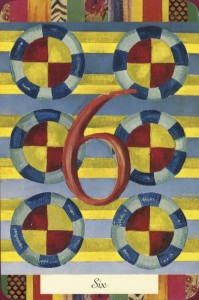 The sixth factor of the Noble Eightfold Path is samba vayama, usually translated as Wise (or Right) Effort.
The sixth factor of the Noble Eightfold Path is samba vayama, usually translated as Wise (or Right) Effort.
In Dancing with Life, Phillip Moffitt writes:
“Right effort is directing your attention so that you are not helplessly caught in the various mind states that arise. The Buddha describes four kinds of wise effort: avoiding unhealthy mind states; abandoning unhealthy mind states once they have arisen; moving the mind to healthy mind states; and maintaing the mind on healthy mind states that have already arisen.
“Attention is a function of the mind and is subject to training, although it often seems as if this is not so. However, energy follows attention, therefore whatever you place your attention on is what will receive energy in your life.
“Right effort is classically associated with working with your mind in meditation, but it also applies to working with your mind states in daily life. If you have a choice, you do not place your attention on thoughts that do not serve you, and you move away from thoughts that are obsessive, contracting, and limiting. Practicing these two forms of right effort doesn’t mean that you should seek to never have difficult thoughts; it just means that you shouldn’t stay stuck on them…
“Instead you would move your attention from identifying with the terrible thoughts to the suffering that is contained in the thoughts, which in turn will give rise to compassion and give you clarity to see how you are getting caught in whatever hurt you….
“Instead of being caught in reactive mind, you are able to accept that life includes such difficulty, i.e., ‘Betrayal feels like this.’ Do you see how this is right effort? Your external conditions and your emotional experience are no different, but you are no longer being defined by your emotional reaction. Amazingly, right effort really does work this way; it is not just some abstract idea.”
**
The phrase that stands out the most for me in this section is: energy follow attention. So as I prepare to retire at the end of next week, and get ready to go on my first 6-week retreat, I plan to be careful about where I place my attention. I don’t want to give any extra energy to anxiety about money or family or health or what’s going to happen in the future. I want all my energy to go toward doing whatever I can do in this present moment…including making responsible plans for the future….and then being open and able to respond to whatever actually does happens in the next present moment. Stay tuned.
Up next: Wise Mindfulness
